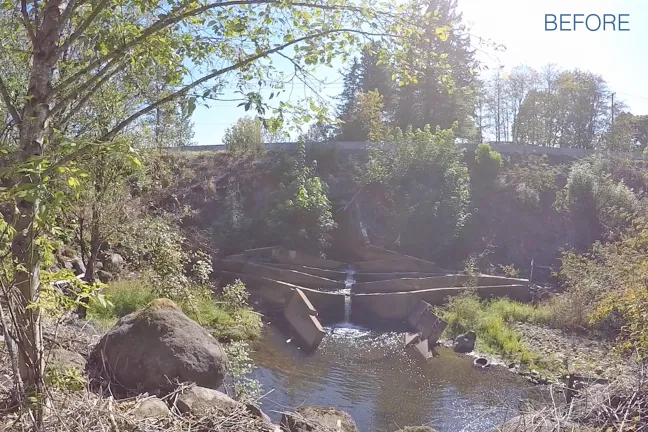One of the largest county road construction projects in recent years was completed this fall. SE Stark Street near Mt. Hood Community College reopened to traffic in October after installation of a 150-foot long culvert that will improve the ecosystem of Beaver Creek and add needed capacity to Stark Street.
Watch the timelapse video of the project.
The $2.1 million project closed a short section of Stark Street in late June during construction of an open-bottom arch culvert that carries Beaver Creek under the road. Contractor Thompson Brothers excavated about forty feet down from the roadway to remove an old, failed culvert and fish ladder, and to install a new-fish friendly culvert.
A large canyon was excavated so that the longer and wider steel culvert could be built, along with concrete head walls to protect the culvert and Stark Street during high creek flows.
Rainfall in September and October created construction challenges, as well as groundwater that had to be pumped from the work zone throughout the project. The original reopening date of October 6 was extended by two weeks.
The new culvert will improve upstream migration for salmon and the downstream movement of wood and sediment. The old culvert was roughly 10 feet square, and the old fish ladder was no longer functional, which created a jump barrier for returning adult salmon in the fall, as well as for all other native fishes throughout the year. The new culvert is about 40 feet wide and 20 feet high, and has a natural stream bed throughout its length.
Beaver Creek is one of the region’s healthiest urban salmon habitats. Nearly 10% of the Coho salmon produced in the major tributaries of the Sandy River come from Beaver Creek. The stream winds through neighborhoods in Gresham and Troutdale and rural areas. 13 native fish species can be found in the creek, including Coho and Chinook salmon, and steelhead trout.
Narrow culverts installed a hundred years ago when roads were built blocked migrating fish from the upper reaches of the creek. New culverts will reopen access to good spawning habitat area. Salmon were seen at the Stark Street culvert a few weeks after construction was completed in October, including the sighting of Chinook adults. The first since fish monitoring began ten years ago.
Multnomah County plans to improve two other road culverts -- also fish barriers -- on Beaver Creek in the next two years. This will provide increased access to several upstream miles of stream habitat to threatened fish species.
The new culvert under Stark Street will also allow Multnomah County to widen Stark Street between Kane Road/257th and Troutdale Road to two lanes in each direction, along with sidewalks and bike lanes. The road widening is tentatively scheduled for 2020.


